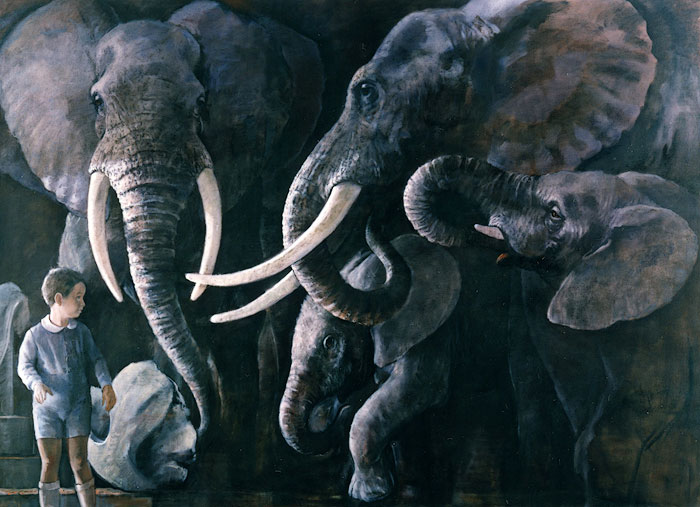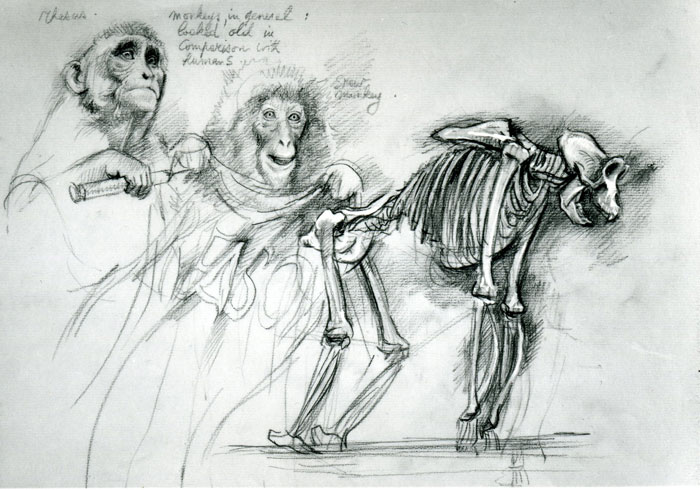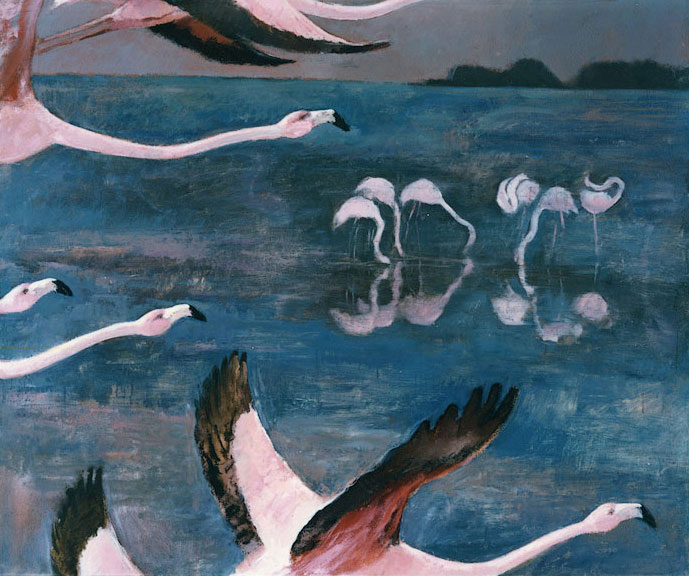August 22, 1988 The elephant females are nursing their calves, the survival and hope of life itself. The elephants also suggest the past, in the same way that De Kooning's Excavations painting seems to me to relate to an archeological dig. The great memory of the elephant is part of what an elephant is. Our concept of time is based on the existence of memory as a sense of order over disorder.
July 31, 1989 Death: I worked on three monkeys today. I must concentrate on meaning. My monkeys are not unlike the soldiers of Tintoretto's Crucifixion. I used them to show the dark side of today's world: wars, ignorance, gossip, idleness, posturing and covering asses. Melancholia is setting in, an early companion to civilization. January 25, 1992 Love survives death. The Chinese say that in the mouth the tongue survived the teeth. March 17, 1992 Unlike Picasso and Matisse, Erich Fischl noted in a lecture today, Bonnard stuck to the same "model", Marthe, all his life. Fisch, pointed out that Bonnard's relentless pursuit of the same other paid off: Bonnard's paintings became emotionally charged, an existential search for his own self. That is the way I too understand Bonnard. His seemingly prosaic statements became deep marks of his affection for Marthe. In the same spirit I want my exploration of desire to be the first steps toward love, as the gestures of desire mingle with the gestures of affection. April 3, 1992 Each person, in a Titian painting, speaks to us. These human voices stop with Cezanne who realized that the traditional societal structures were crumbling in his time. He fought for a new internal structure of the painting, self-contained, and independent of worn-out illusionism. In the process, however, he lost some of the old power to communicate, which Titian and Rembrandt had. April 5, 1992 When touching in desire becomes affectionate, the gentleness acts like music. In Desire, the melody played on the flute by Christine is heard over the rushing noise of the mountain stream inducing the softer tones of affection to mingle with desire. The flute is the instrument of love. April 21, 1992 (Translated from today's letter of my Belgian aunt, the writer Marie Denis.) "I am imagining the space of the four walls and the story contained in your pictural composition, a story which is coming out of the paintings to meet that which we call the eternal - that which has no end. ( ... ) The naked body is very moving, it is much more than a body, it is offered to love; even the very old bodies that one discovers when taking care of them. I like very much your theme of the Pieta: the part, attitude and emotion, that the circumstances give women to share, but it is human - which concerns all of us. Priam coming forward to beg for giving him back Hector’s body. July 18, 1992 The wings of the flamingoes in Caring remind me of watching pedestrians crossing 57th Street in New York City when I was at the Arts Students League. The sudden unfolding of energy by swarms of pedestrians at the change of the light gives clarity to body movements and individual characters. The wings remind me of the swirls of triangles that Robert Goodnough, who had been inspired by the same New York pedestrians, painted in the very large abstract canvases I saw when a student. July 19, 1992 The Great Wave at Kanagawa, the Hokusai print of the Mount Fuji series, is still hanging in my mother’s apartment. The print came from a great uncle, a painter himself. Today as I am painting my flock of flamingoes starting to fly in front of the two women and the child, I suddenly understand what I have borrowed from the composition of the Wave: the powerful wings of the birds like the great wave almost engulfing the human group - which is strengthened in my case by the power of caring as it was for Hokusai by discipline and team work. July 21, 1992 I find myself struggling in a seemingly impossible narrative mode when so much artwork of this century - from ready made to minimalist and conceptual work obliterates any direct emotional involvement. In the present dizzying pace of life, is there time and hope to develop true emotions ? Christine, so compassionate herself and spending her life to help disadvantaged people, could not get out of her own depression which she once described to me as going down in a spiral of darkness, the light above receding further and further. (Her comment was the source of my composition for the Death movement.) I and many friends did everything possible to help Christine. Her death is one of the main reasons that I must go on painting human dimensions of light, space and time to give others the possibility of hope and feelings.
July 22, 1992 Flamingoes need the hot air of the tropics to raise their offspring, human babies need warm cuddling to develop well. All forms of life need warmth. July 23, 1992 Today is on age of disbelief. Everything is in question. We, the artists, don't even know how to represent space because now each one of us must discover the personal relation to space. Remember Augustine: "We all know what time is until we try to define it". So we must continuously recreate our own space where we only believe what is offered to our face. This "face-to-face" is our anchor in reality, but already we don't quite trust the story that comes with the face. We only trust our own story. Thus an art work today is like on emotional melody contained in a series of personal folds of space and time. August 3, 1992 Last night I dreamt that I ate some green color and I was trying to spit it out. I was working on a very large painting of several fenced fields. Next to a fence I found a tiny baby cow - it fitted in my hands - and I brought it back to its mother. August 4, 1992 I started as a painter in New Orleans by making fifty four paintings of Dixieland jazz musicians who revived in the late fifties. They were playing music when I painted them. Ever since then painting has been music for me. But I was nevertheless startled this afternoon, when listening to a recording of an extended jazz piece played in 1982 by the Chicago Art Ensemble. To me the sax, the altosax and the drums sounded like brushstrokes, a visual feast still somehow attached to a melodic line, a set equivalent to my painting. The birds flopping the wings, their explosive strokes seem to come out of raw, moody, plaintive and joyous jazz. October 23, 1992 Caring is the key word. How can it be convincingly expressed in the painting? Today the movie, the video carries the most direct power to convince. Can a static image still carry some punch? For instance death is rarely faced now in paintings; we have very few art works equivalent to Giotto's Lamentation or the Pietas of Michelangelo or the Death of Marat by David. Each of these works reached the highest emotional pitch of it's era. They were and still are original. There is a deep resonance between the inner structure and the subject matter. They were not only created within the context of their times, they have come to represent their times. In other words, they are the reality of their times. Because death is not usually understood anymore in the religious context, it requires a new context. A tragic death is understood in a movie, because there is a story giving it both its plausibility and its convincing power. By contrast death presented in a single image has an unsettling starkness. I needed a complete cycle about love and caring so that Christine's death could be seen in a new light.
The Symphony for Christine relies on traditional means, in particular on what Carl Jung calls “ quaternity”. It is found in Western civilization as the cardinal directions, the four elements, the four seasons, the religious cross, the four gospels, etc paintings, photographs, screens have usually four sides and four corners. But like in a symphony, which usually has three or four movements, there is a suggestion in quaternity of a return to the beginning after having pulled together all the new elements. This implies the myth of eternal return. My painted Symphony uses quaternity (including midday, evening, night and morning), but its purpose, like in most contemporary music, is about the arrow of time, a predicament of no return. As we are entering a planetary age, it seems to me that quaternity is becoming one phase in the history of ordering chaos and is now slowly absorbed by a larger more subtle conception of order, one based on the direction of time. I further believe that the awareness of directional time will help the growth of altruistic love, as it will appear evermore necessary for survival. September 30, 1992 I painted first Love, which became eventually the last movement of the Symphony. I have come to understand it as the spirit of Christine guiding the united lovers out of the depth of the water toward the light. The symbiosis achieved between the anemones and the sea 450 million years ago is a prefiguration of tomorrow. The direction of time in this planet biosphere is defined by a progressive ordering of chaos: the evolutionary increase of memory, the sense of delayed purpose, the increased awareness of one's own actions and mortality, the creation of every new artifact, every scientific discovery, the slowly gaining equality between men and women and its resulting opening toward deeper feelings of love. Thus it makes sense that we are becoming evermore responsible for the new forms of life.
|



